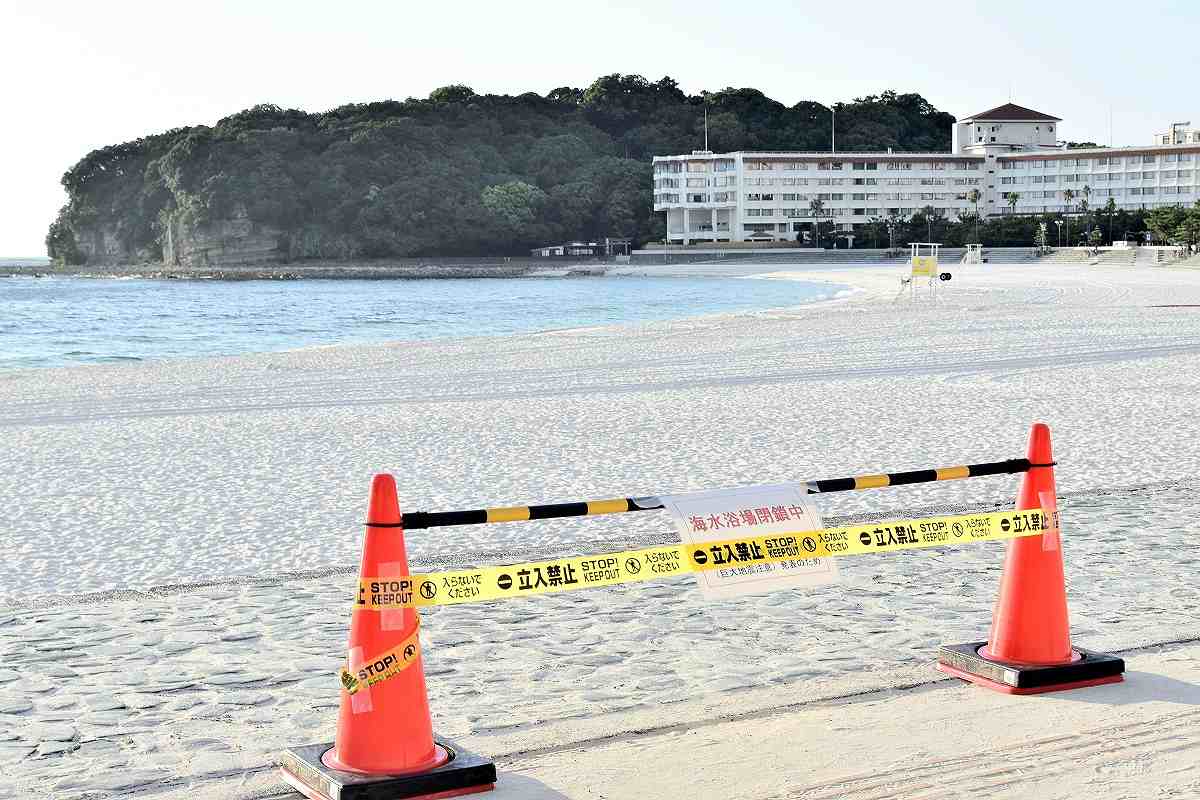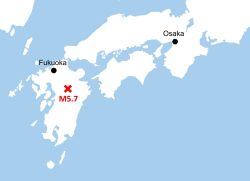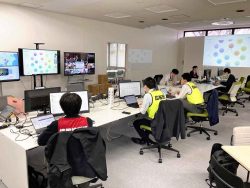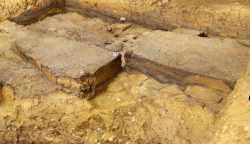Local Authorities Differed in Response to Mega Quake Warning; Effective Prevention Measures Vital Ahead of Major Disasters

A beach is closed to the public in Shirahama, Wakayama Prefecture, on Aug. 11 after a special advisory was issued urging residents to be on guard against a possible Nankai Trough earthquake.
6:00 JST, September 2, 2024
WAKAYAMA / KOCHI — The government issued a special advisory for the first time last month urging residents of certain areas to be on guard against a possible Nankai Trough earthquake, but local governments differed in their response, resulting in some disruption.
Called the Nankai Trough Earthquake Extra Information, the advisory was issued in response to a magnitude-7.1 earthquake that occurred in the Hyuganada Sea off Miyazaki Prefecture on the evening of Aug. 8. The quake’s epicenter was located within the presumed focal region of an anticipated Nankai Trough earthquake.
There have been numerous natural disasters this year, including the Noto Peninsula Earthquake and typhoons. Sunday was Disaster Prevention Day, and it is imperative that the special advisory lead to effective disaster-prevention measures ahead of the major earthquakes and other disasters that are expected to occur at some point.
“People’s safety is the top priority, but we have also had some hard times,” said the general manager of a hotel in Shirahama, Wakayama Prefecture, on the Pacific coast.
The Aug. 8 earthquake drastically changed the situation in Shirahama, which had been crowded with tourists until then.
The tremor occurred at the western edge of the presumed focal region of a Nankai Trough earthquake. Believing that the possibility of a devastating megaquake in the Nankai Trough area was higher than normal, the government therefore issued the special advisory — covering 707 cities, towns and villages in 29 prefectures — for the first time since the warning system regarding a Nankai Trough earthquake was introduced in 2019.
The town of Shirahama, where 16-meter-high tsunami are expected just four minutes after a Nankai Trough earthquake, closed four beaches from Aug. 9 to 14. “It was a difficult decision to protect the safety and security of our tourists,” a town official said.
Limited express train services to the town were also suspended, causing many cancellations for the hotel. The advisory was lifted on Aug. 15, but “the effects are still being felt,” the hotel manager said.
On Aug. 21, Shirahama Mayor Yasuhiro Oe submitted a written request to the Japan Tourism Agency seeking cooperation in measures to bring visitors back to the town. Accommodation facilities had suffered losses of at least ¥500 million, Oe said.
When issuing the advisory, the government asked targeted municipalities to reconfirm their earthquake preparedness, among other measures, but did not name any specific measures they should take. This prompted a municipality on the coast in Wakayama Prefecture to cancel a fireworks festival.
“The organizer of the festival must have worried a lot about what to do regarding the event, since it had never experienced such a situation before. I hope the national government will establish unified rules regarding the advisory,” Wakayama Gov. Shuhei Kishimoto said.
Preemptive evacuation
Local governments also were divided over the preemptive evacuation of people in need of extra help, who might be slow to escape in the event of tsunami and other emergencies.
According to a Yomiuri Shimbun survey, at least 24 municipalities in Kochi, Aichi, Kagoshima and Wakayama prefectures opened evacuation centers at a total of 139 locations.
After the advisory was issued on Aug. 8, the town of Kuroshio, Kochi Prefecture, which could be hit by a tsunami as high as 34 meters in the event of a Nankai Trough earthquake, issued an alert for the entire municipality on the same day. The town’s alert called for the evacuation of the elderly and other people in difficulty, based on the belief that it would be impossible for them to evacuate after such a major quake.
The town set up 36 evacuation centers, and town officials directly urged about 230 people who would find it difficult to flee by themselves in the event of an emergency to evacuate.
Only seven people evacuated, but issues remain to be addressed regarding the town’s readiness to receive evacuees, as people were required to bring their own food and bedclothes to evacuation centers.
The municipality of Minami, Tokushima Prefecture, decided not to open evacuation centers, in accordance with the national government’s call for people to lead normal lives while taking precautions.
Local disaster response plans
Following the issuance of the advisory, national and local governments are reexamining their disaster preparedness measures.
The cities of Tsu and Takasago, Hyogo Prefecture, plan to incorporate staffing arrangements and information transmission methods into their local disaster prevention plans. The national government intends to conduct a survey of local governments and business operators to identify issues that surfaced as a result of the advisory.
“The special advisory had an impact in various areas partly because it was issued during the summer vacation season,” said Yoshifumi Matsumura, minister of state for disaster management. “We need to examine what kind of information needs to be disseminated and how we should cooperate with local governments to take appropriate measures.”
“Situations vary from region to region in terms of the anticipated damage and regarding how many evacuation facilities are set up in what way. So even if national rules are set up, they will have limited effectiveness,” said Ryosuke Aota, a professor of disaster relief policy at the University of Hyogo.
“Local authorities should establish in advance the measures to be taken when a special advisory is issued, based on local conditions and residents’ opinions,” the professor said.
"Society" POPULAR ARTICLE
-

M4.9 Earthquake Hits Tokyo, Neighboring Prefectures
-

M7.5 Earthquake Hits Northern Japan; Tsunami Waves Observed in Hokkaido, Aomori and Iwate Prefectures
-

Tsukiji Market Urges Tourists to Avoid Visiting in Year-End
-

Israeli Tourists Refused Accommodation at Hotel in Japan’s Nagano Pref., Prompting Protest by Israeli Embassy and Probe by Prefecture
-

M5.7 Earthquake Hits Japan’s Kumamoto Pref., Measuring Upper 5 Intensity, No Tsunami Expected
JN ACCESS RANKING
-

Keidanren Chairman Yoshinobu Tsutsui Visits Kashiwazaki-Kariwa Nuclear Power Plant; Inspects New Emergency Safety System
-

Imports of Rare Earths from China Facing Delays, May Be Caused by Deterioration of Japan-China Relations
-

University of Tokyo Professor Discusses Japanese Economic Security in Interview Ahead of Forum
-

Japan Pulls out of Vietnam Nuclear Project, Complicating Hanoi’s Power Plans
-

Govt Aims to Expand NISA Program Lineup, Abolish Age Restriction






















